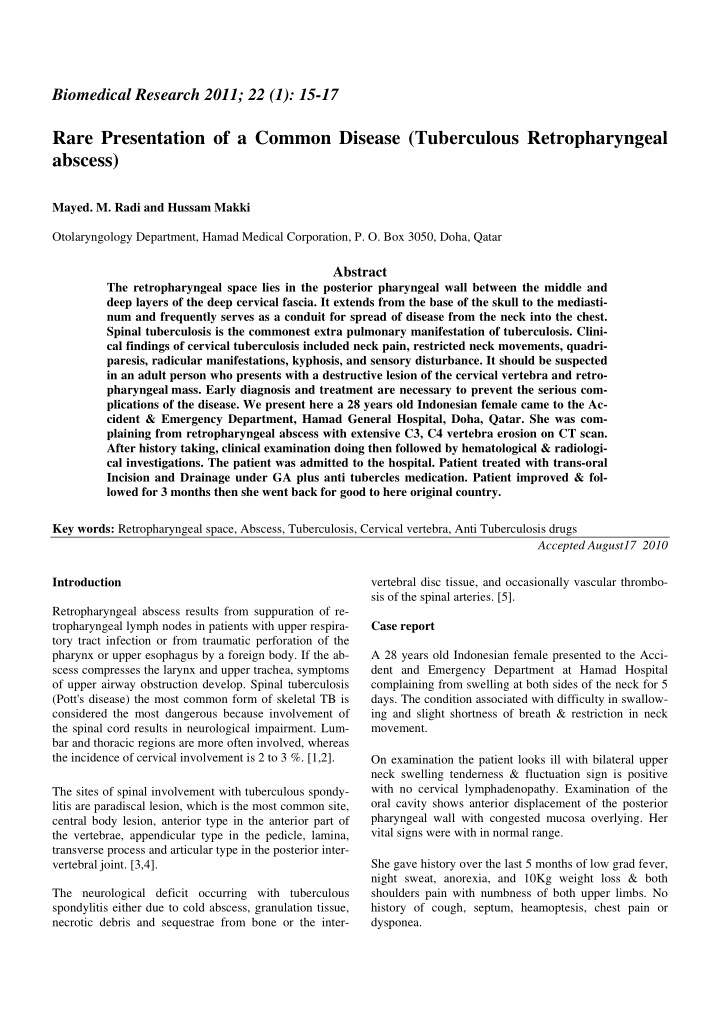



Biomedical Research 2011; 22 (1): 15-17 Rare Presentation of a Common Disease (Tuberculous Retropharyngeal abscess) Mayed. M. Radi and Hussam Makki Otolaryngology Department, Hamad Medical Corporation, P. O. Box 3050, Doha, Qatar Abstract The retropharyngeal space lies in the posterior pharyngeal wall between the middle and deep layers of the deep cervical fascia. It extends from the base of the skull to the mediasti- num and frequently serves as a conduit for spread of disease from the neck into the chest. Spinal tuberculosis is the commonest extra pulmonary manifestation of tuberculosis. Clini- cal findings of cervical tuberculosis included neck pain, restricted neck movements, quadri- paresis, radicular manifestations, kyphosis, and sensory disturbance. It should be suspected in an adult person who presents with a destructive lesion of the cervical vertebra and retro- pharyngeal mass. Early diagnosis and treatment are necessary to prevent the serious com- plications of the disease. We present here a 28 years old Indonesian female came to the Ac- cident & Emergency Department, Hamad General Hospital, Doha, Qatar. She was com- plaining from retropharyngeal abscess with extensive C3, C4 vertebra erosion on CT scan. After history taking, clinical examination doing then followed by hematological & radiologi- cal investigations. The patient was admitted to the hospital. Patient treated with trans-oral Incision and Drainage under GA plus anti tubercles medication. Patient improved & fol- lowed for 3 months then she went back for good to here original country. Key words: Retropharyngeal space, Abscess, Tuberculosis, Cervical vertebra, Anti Tuberculosis drugs Accepted August17 2010 Introduction vertebral disc tissue, and occasionally vascular thrombo- sis of the spinal arteries. [5]. Retropharyngeal abscess results from suppuration of re- tropharyngeal lymph nodes in patients with upper respira- Case report tory tract infection or from traumatic perforation of the pharynx or upper esophagus by a foreign body. If the ab- A 28 years old Indonesian female presented to the Acci- scess compresses the larynx and upper trachea, symptoms dent and Emergency Department at Hamad Hospital of upper airway obstruction develop. Spinal tuberculosis complaining from swelling at both sides of the neck for 5 (Pott's disease) the most common form of skeletal TB is days. The condition associated with difficulty in swallow- considered the most dangerous because involvement of ing and slight shortness of breath & restriction in neck the spinal cord results in neurological impairment. Lum- movement. bar and thoracic regions are more often involved, whereas the incidence of cervical involvement is 2 to 3 %. [1,2]. On examination the patient looks ill with bilateral upper neck swelling tenderness & fluctuation sign is positive with no cervical lymphadenopathy. Examination of the The sites of spinal involvement with tuberculous spondy- oral cavity shows anterior displacement of the posterior litis are paradiscal lesion, which is the most common site, pharyngeal wall with congested mucosa overlying. Her central body lesion, anterior type in the anterior part of vital signs were with in normal range. the vertebrae, appendicular type in the pedicle, lamina, transverse process and articular type in the posterior inter- vertebral joint. [3,4]. She gave history over the last 5 months of low grad fever, night sweat, anorexia, and 10Kg weight loss & both The neurological deficit occurring with tuberculous shoulders pain with numbness of both upper limbs. No spondylitis either due to cold abscess, granulation tissue, history of cough, septum, heamoptesis, chest pain or necrotic debris and sequestrae from bone or the inter- dysponea.
Figure1. Sagital CT scan image with contrast showing Figure2. Axial CT scan image showing the prevertibral the big abscess extending to the level of posterior aspect collection (retropharangeal & parapharangeal) at level of superior mediastinum with narrowing of supragllotic of C3. Carotid vessels displace laterally. area. There is marked erosion of C2 & C3 vertebra. She did not complain from any chronic illness & she did not take any medication. Urgent Ultrasound and CT scan was done. It confirms a (right side 5.9*3.8 cm & left side 2.3*83.0 cm) retro- pharyngeal abscess with extensive C2, C3 anterior ero- sion. Hematological investigation shows: WBC 6.4 mainly po- lymorph, hematocrit 34.8, ESR 103 mm/h. Admission of the patient to the hospital put her on dual aerobic and anaerobic empirical IV antibiotic medications (Rocefine, Clindamycin). With in less than 12 hours from admission patient was on the Operating room table. Under GA trans-oral drainage of this big abscess took place. Swab was taken for gram stain, Acid-fast smear, culture and sensitivity. 2 days later the result of the smear came with positive for acid fast bacilli (4 AFB/100 Fields), Infectious teem con- Figure 3. Lateral CT scan image with out contrast show- sulted & they transfer the patient to an isolated room & ing the big abscess. There is marked erosion & rarefac- they starts Anti TB medications (INH, Pyridoxine, Ri- tions of C2 & C3 vertebra. fampicin, Ethambutol, Pyrazinamide) for 6-12 months. any sign for pulmonary TB. On the 4 th day MRI on the A Neurosurgery physician consulted to examine her. The neck did which shows mild recollection at the same place patient dose not shows any neurological deficit. He rec- of the previous abscess. ommends wearing a Philadelphia neck collar for her & follows up at out patient. Patient followed up with daily hematological investiga- tions and clinical examination. She starts to improve dra- Early morning sputum samples was collected for 3 con- matically from her presenting symptoms. Patent dis- secutive days was negative for acid fast bacilli, blood cul- charged from the hospital after 10 days & referred to the ture was negative as well as the chest x-ray did not show
Recommend
More recommend